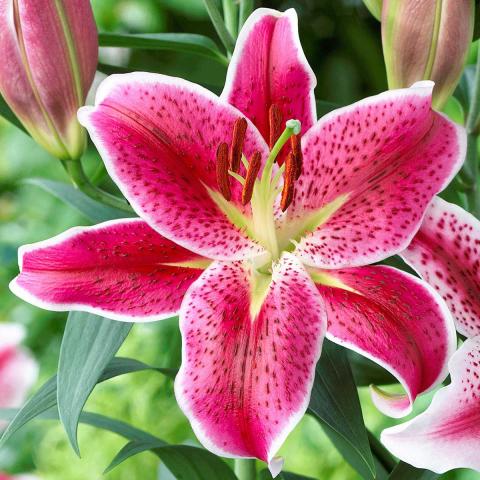With large, showy blooms, lilies add striking elegance in the garden from early to midsummer. Grown from bulbs, these perennial flowers are best planted in the autumn and will return year after year with minimal care—as long as they’re planted in the right place. Learn more in our Lilies Growing Guide.
Lilies have six plain or strikingly marked tepals (“petals”) and are often trumpet-shaped, sitting atop a tall, erect stem with narrow, long, lance-shaped leaves. They come in many beautiful colors, including pink, gold, red, orange, and white.
There are a number of popular lily species—and their endless hybrids—available to gardeners:
- Asiatic lilies bloom first in early summer (in May or June), right after peonies. They are not fussy as long as they are grown in well-draining soil. They are the shortest type of lily (about 2 to 3 feet tall) and come in many colors, from pastel to tropical. They don’t have much of a fragrance, but they do add bright color to the garden.
- Easter lilies are most commonly grown indoors as a holiday plant. As their name suggests, they are typically forced into bloom around Easter, in March or April. Outdoors, they are better suited for warmer regions of North America, where they can be planted in the garden after blooming has finished.
- Oriental lilies have that famously strong fragrance. They are tall and stately (4 feet), and tend to grow more slowly, often blooming about the time when Asiatic lily flowers are fading (mid- to late-summer).
- Trumpet lilies are similar to oriental lilies, producing many blooms with a nice scent. Their flowers tend to be smaller and more closed (like a trumpet) than those of the other lilies.
There are other lilies out there, of course, such as tiger lilies and Turk’s cap lilies, as well as hybrids like “Orienpet” (Oriental + Trumpet) and LA lilies (Easter + Asiatic). Browse through your favorite online gardening retailer’s catalog to find what you like best!
Get to Know the “True Lilies”
There are many plants with “lily” in the name, but most are not what we call “true lilies.” True lilies grow from onion-like bulbs and are of the genus Lilium.
Daylilies (Hemerocallis spp.), despite the similar appearance of their flowers, are not true lilies. Daylilies have many leaves that grow from a crown, whereas true lilies generally have only one stem or shoot that grows from a bulb. Similarly, peace lilies, canna lilies, water lilies, lily-of-the-valley, and calla lilies are not true lilies either! Learn more about what makes a lily a lily.
When Do Lilies Bloom?
Lilies tend to bloom from early summer to fall, depending on the type. By carefully blending early, mid-season, and late varieties into your garden, you will enjoy their magnificent blooms from spring through first frost. At home in both formal and naturalistic settings, most lilies also take readily to containers. Plus, they make great cut flowers!
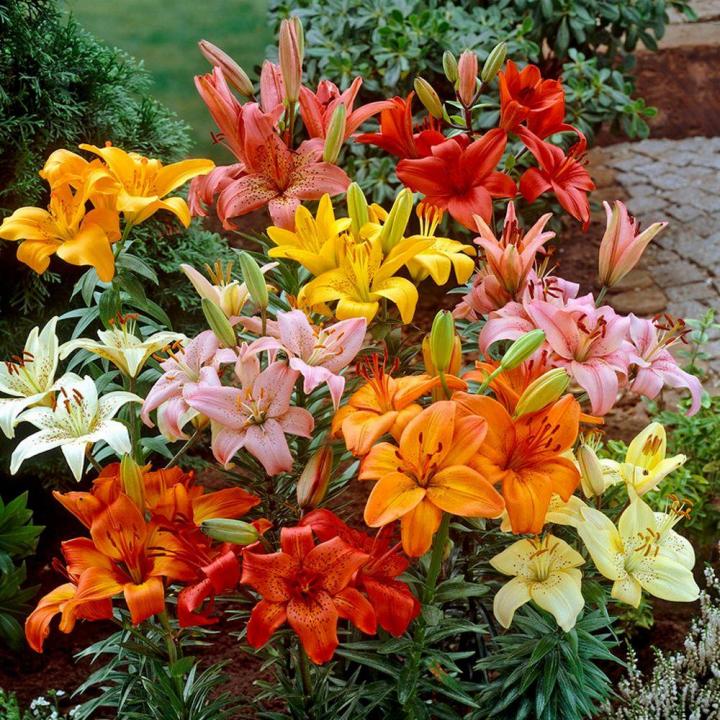
When to Plant Lilies
- In most regions, plant lily bulbs in the fall, at least four weeks prior to your first fall frost date. Bulbs planted in the autumn will have well established roots in the spring. The bulbs benefit from a winter chill to produce big blooms.
- In areas with particularly harsh winters, consider planting in the spring instead. Plant as soon as the threat of frost has passed.
- Container-grown lily plants can be planted anytime during the early summer.
- Buy the bulbs close to planting time. Because lily bulbs don’t go dormant, they will deteriorate over time, so don’t plan to buy bulbs in the fall and wait until spring to plant them.
Choosing and Preparing a Planting Site
- Select a site with soil that drains well. How can you tell? After a good rain, find a spot that is the first to dry out. Water trapped beneath the overlapping scales on the lily bulb may cause rot, so a well-drained site is essential.
- Lilies need lots of sun. For dependable blooms, lilies need 6 to 8 hours of direct sunlight a day (aka “full sun”). If it’s too shady, the stems will attempt to lean towards the sun or get spindly and fall over.
- Most of the popular varieties prefer acidic to neutral soil, but some are lime-tolerant or prefer alkaline soils (e.g., Madonna lilies).
- Loosen the soil to a depth of 12 to 15 inches. The deep planting encourages the developing stem to send out roots to help stabilize the plant and perhaps eliminate the need for staking. Also, deep planting keeps lily bulbs cool when temperatures soar.
- Enrich the soil with leaf mold or well-rotted organic matter to encourage good drainage. Learn more about soil amendments and preparing soil for planting.
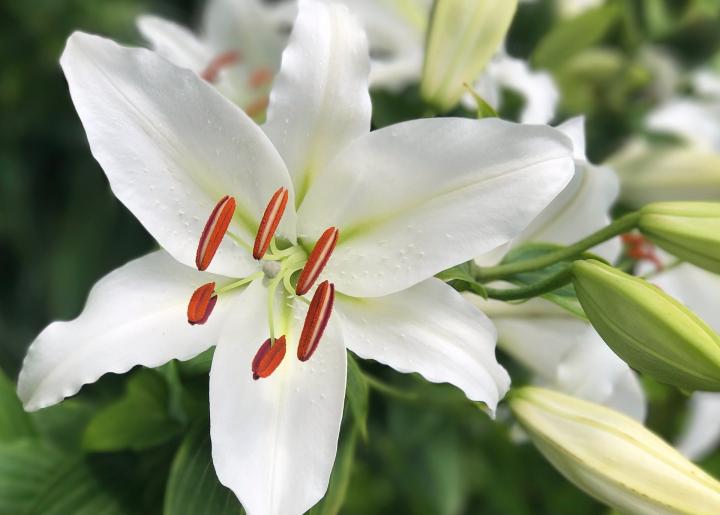
How to Plant Lilies
- Plant the bulbs 3 times as deep as the height of the bulb and set the bulb in the hole pointy side up. Fill the hole with soil and tamp gently.
- Space bulbs at a distance equal to three times the bulb’s diameter (usually about 8 to 18 inches apart, depending on the variety).
- For visual appeal, plant lilies in groups of 3 to 5 bulbs.
- Water thoroughly at time of planting.
See more tips on how to grow lilies.
How to Care for Lilies
- During active growth, water freely—especially if rainfall is less than 1 inch per week.
- Keep lilies mulched so that their roots are cool. The mulch should feel moist, but not wet. Read more about mulching.
- Apply a high-potassium liquid fertilizer every 2 weeks from planting until 6 weeks after flowering.
- Apply a thin layer of compost each spring, followed by a 2-inch layer of mulch.
- Stake tall lilies.
- Lilies do not bloom more than once per season, but you can remove the faded flowers so that the plants don’t waste energy making seeds.
- After the lily blooms, you can also remove just the stem itself. However, do NOT remove leaves until they have died down and turned brown in fall. It’s very important not to cut back the leaves until the end of their season because hey help provide nourishment to the bulb for next season’s blooms.
- Cut down the dead stalks in the late fall or early spring.
- Before winter, add 4 to 6 inches of mulch, simply to delay the ground freeze and allow the roots to keep growing. Leave the mulch until spring once the last hard frost has passed. See your local frost dates. See your local frost dates.
- If your region doesn’t have snow cover, keep soil moist in winter.
- When lily shoots grow through the mulch in the spring, start to remove it gradually.
- Divide plants every 3 to 4 years as new growth begins in the spring. Just lift the plants and divide the clumps. Replant the new bulbs adding some compost.
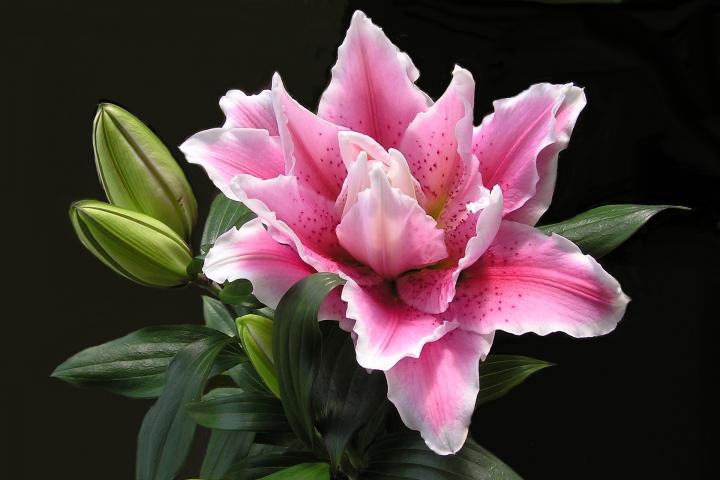
- Gray mold is sometimes a problem, especially in a wet, cool spring or summer. Make sure lilies are not crowded and have plenty of air circulation.
- Viruses, spread by aphids, may be troublesome, although some cultivars are virus-tolerant.
- Red lily beetles, slugs, and snails may occur.
- Deer, rabbits, voles, and groundhogs may eat entire plants. If these critters are a problem, plant the bulbs in buried wire cages to protect them from getting eaten.
There are many types of lilies which bloom at different times. With some careful planning, you can enjoy lilies all summer long by planting bulbs from different varieties.
Asiatic lilies are the earliest to bloom and the easiest to grow. With their upward facing flowers, they bloom early to midsummer. Hardy in Zones 4 to 9, Asiatic lilies come in pure white, pink, vivid yellow, orange, and red. Intense breeding has erased much of the Asiatics’ fragrance, but in spite of their lack of perfume, they are a favorite with floral arrangers.
- ‘Crete’: deep pink, blooms June to July, 3 to 4 feet tall
- ‘Enchantment’: orange, blooms in June, 2 to 3 feet tall
Trumpet lilies bloom mid-summer. Tall with trumpet-shaped flowers, they are hardy in Zones 5 to 9. Trumpet lilies grow many blooms (12 to 15 per stalk!) and have a wonderfully heady, sweet fragrance.
- ‘Regale’: white, blooms early to late summer, 3 to 4 feet tall
- ‘Rising Moon’: pastel yellow with a pink edges, blooms in mid-summer, 3 to 4 feet tall
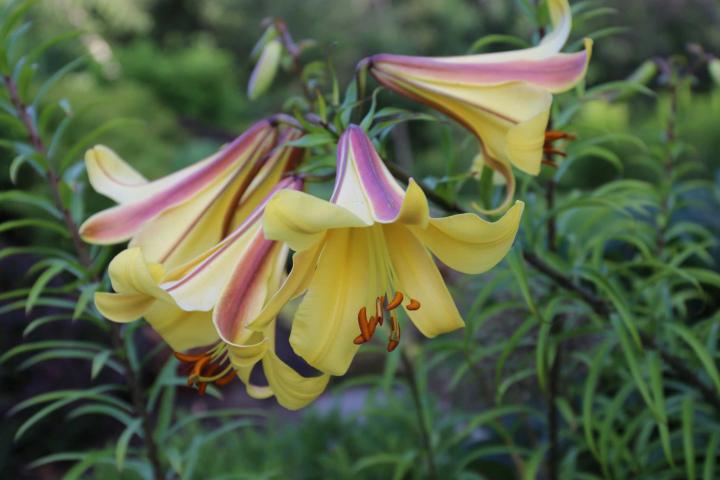
Oriental hybrids end the season, blooming in mid- to late summer, just when Asiatic lilies are beginning to fade. From tiny 2-footers to towering 8-foot-tall giants, Orientals are always a striking choice (the shorter ones are great for patio beds or container gardens). Adored for their intoxicating fragrance that intensifies after dark, Oriental lilies produce masses of huge white, pink, red, or bi-color blooms. They make wonderful cut flowers that will fill even the largest of rooms with their spicy scents.
- ‘Black Beauty’: dark red, blooms in late summer, 5 to 6 feet tall
- ‘Casa Blanca’: white, blooms August to September, 4 to 5 feet tall
Displaying Lilies in Vases
-
Lilies make wonderful cut flowers. However, avoid cutting off more than a third of the stem. Taking more than that can reduce the plant’s vigor and longevity, since the plant needs its foliage to create energy.
-
If you are growing lilies strictly for cut flowers, consider planting them in a designated cutting garden, where you can plant fresh bulbs each year.
-
When cutting lilies, choose those with buds that are just about to open, with a bit of the flower color showing. The higher up buds will open as the bottom ones fade.
-
Just one lily stem in a vase can be a show-stopper.
-
As soon as you get lilies inside, trim the stem ends an inch or so, making a diagonal cut with a sharp knife.
-
If you worry that the orange pollen of lilies might cause stains, simply snip off the stamens in the flower’s center.
-
Before arranging in a vase, remove the lower leaves on the stems so that no foliage will be underwater.
-
A good lily arrangement will last two or more weeks. Change the water every few days.
-
To help prolong the flowers’ life, add cut-flower food to the water. Lilies require only half the amount of food recommended for other flowers.
Learn how to keep cut flowers fresh.
- The name “lily” can be misleading because lots of other plants use it besides true lilies. Daylilies and water lilies aren’t lilies at all, and neither are lilies-of-the-valley or lilyturf. With so many other plants using the name “lily,” it seems that identity theft has been around since long before the use of computers and credit cards!
- Easter lilies can be planted in the ground in the spring. They may survive several years if you mulch them heavily in the fall, especially in northern regions. If they survive, they’ll bloom in late summer.
- In a flower bed, lilies prosper in the presence of low-growing plants that protect the lilies’ roots from drying out.

